7th Convalescent Hospital Unit History

Colonel William B. Wilson, MC was assigned as the Commanding Officer for the 7th Convalescent Hospital from 21 February 1944 – 6 February 1945.
Activation & Early History:
The 7th Convalescent Hospital was officially activated on 15 July 1943. The cadre for the unit was drawn from Fort McPherson, Georgia, Camp Barkeley, Texas, Camp McCoy, Wisconsin all converging at the location that would eventually be known as Camp Ellis, Illinois. Upon the unit’s arrival at the location, very few facilities existed, save for huts used for stationing. There were no walkways or streets at the new Camp. However, the troops unloaded their equipment and prepared for breakfast. Shortly after lunch on 15 July, the Hospital personnel thus far recruited were introduced to the Officers of the unit:
Major Vincent J. Amato – Commanding Officer
Captain Donald N. Abbot – Supply and Training Officer
1st Lieutenant Kavanaugh – Detachment Commander
1st Lieutenant John Speca – Mess Officer
1st Lieutenant Hubert F. Smith – Adjutant
1st Lieutenant Blumberg – Medical Supply Officer
1st Lieutenant Orme – Personnel Officer
The first few days at Camp Ellis were spent unloading personal equipment, familiarizing with the facilities and generally preparing for the series of Training Programs that were to be undertaken. Each member of the cadre was given a short interview by the Commanding Officer, in which he outlined their responsibilities, and asked what they expected from the unit. Following the interviews, Captain Abbot prepared a chart of training, and Lieutenant Orme handled the administration of personnel and prepared insurance for all members.
Training:
The unit moved across large open plains to occupy barracks left by a Signal Corps outfit, rumored to be destined for overseas. Major Amato ignored the rumors however, and ordered Lieutenant Kavanaugh to send the staff to schools and unit training classes. Each morning, small formations grouped in the company area to undertake specialist training in cooking, patient management and Military Law. Most of the classes were given under canvas and led by the Hospital’s senior Officers.
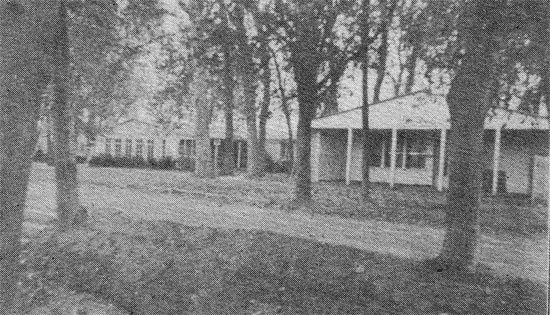
View of the barracks occupied by the unit during its initial stages of training.
It was during this period of intense classroom training that the unit was moved from its location on “36th Street” to a newly completed, permanent area on the Camp – “43d Street”. Before moving, the personnel had been instructed to keep the same corresponding bed locations in the new barracks as in the ones from which they moved. The move had meant that the men were closer to the PX than they had been before, which showed a marked improvement in general well-being and morale.
In addition, a regular train to Chicago provided the ideal opportunity for passes and furloughs, and a good number of the Hospital’s staff regularly made the journey to the “Windy City” over weekends. However, the period of classroom training and weekend passes was short-lived. In readiness for its impending journey overseas, the unit prepared for bivouacking.
On 18 October 1943, the unit entered bivouac at Camp Ellis. Personnel experienced for the first time the daily deportment of a US Army Hospital in the field. Enlisted personnel pitched Shelter Tents and experienced eating meals in the open air. Numerous moulage masks and training aids were acquired to assist with training programs, while extracurricular activities were also provided. The personnel also pitched and struck a number of the tents that would eventually comprise the Hospital’s facility – Ward and Storage Tents were pitched in accordance with the recommended layout for a Convalescent Hospital in the field.
The unit returned to Camp Ellis from its bivouac location on 2 November 1943. This marked the end of the planned training period of 3 months, but the time spent in bivouac had highlighted to all involved that further training was needed to prepare everyone for the move overseas. As a result, additional tasks and responsibilities were assigned to personnel. For example, many Technicians continued with bed-panning and patient management in the Station Hospital, and additional lectures were provided on the treatment of gas casualties, laboratory testing and general Company duty.
The winter of 1943 saw a great many changes to the organization as a whole. Major Amato was promoted to Lieutenant Colonel and in early 1944 was transferred out to assume command of a Hospital Ship (“USAHS Louis A. Milne” –ed). A farewell party was held for the popular former Commanding Officer and for a short time Captain Wandal D. Witt assumed command until Colonel Meisch arrived to replace Amato more permanently. A week after joining the unit, Col. Meisch departed on leave and would never return; whilst away from the unit he fell ill and was thus discharged from the position. A number of other senior Officers were replaced by new recruits, and new Medical Officers also joined the unit: Lieutenant Robert M. Stewart, Captain Willis A. Hasty, Captain Stanley A. Hirchfield, Captain Edward J. Levine with Major Greenberg assuming command as the highest ranking Officer.
On 1 February 1944, a further period of bivouac was announced. The Hospital Technicians were tasked with moving the necessary equipment into the field, while the balance of the unit prepared their individual equipment for the march to the bivouac. Upon arrival, the personnel unloaded their equipment while discussion took place about where exactly the tents should be pitched. With Ward Tents having been successfully pitched, Shelter Tents were then erected along each flank and the unit prepared for a further night in bivouac. The weather was cold and frosty, which caused stiffness of joints the following morning. Pyramidal Tents were pitched, slit trenches prepared and a number of additional classes undertaken, namely in field craft and calisthenics.
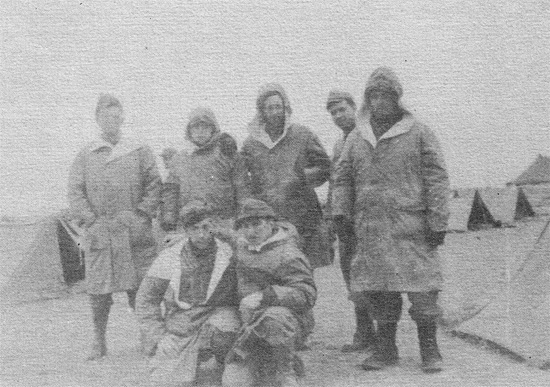
Unidentified members of the unit proudly pose for a photograph with their new issuance of Arctic clothing.
On 12 February, the unit received orders to return to Camp Ellis where it would receive an issue of Arctic clothing. Each member of the unit was given a reversible white and khaki parka coat (complete with an alpaca liner) and a sleeping bag. After the issuance of equipment, the personnel returned to their bivouac for further training and field craft. The comfort didn’t last long however, as the unit was awakened in the middle of the night and ordered to break camp and move to a new location. This change of site was to give all personnel experience in night and blackout movement under field conditions. Upon arrival in the new area, the men were split up into groups of four, and ordered to pitch Shelter Tents with each end buttoned together to create a large shelter sufficiently-spaced for four men.
Having spent several nights in freezing temperatures, the unit finally received orders to prepare for overseas movement. As the last pieces of equipment were loaded into vehicles, the sky darkened and snow began to fall.
Preparation for Overseas Movement:
On 17 February 1944 the 7th entrained and left Camp Ellis for New Jersey. The unit departed at approximately 1500 hours and reached Camp Kilmer at around 1600 the following day. The stay at Camp Kilmer was a short but hectic one, considered by many in the unit to be the epitome of Army life; KP and latrine duty, retreat and reveille, showdown inspections, instructions and classes, chow lines and even passes! Final amendments were made to the unit’s Table of Organization, with additional personnel joining the unit to replace those that were AWOL. Among the personnel assigned was Colonel William B. Wilson, who was appointed as the unit’s new Commanding Officer.
The staff once again entrained at Camp Kilmer and prepared for embarkation on 26 February 1944. Two hours after departure, the trains arrived at the New York Port of Embarkation, and a waiting ferry transferred the personnel to the pier, where the “SS Bienville” was anchored. The unit boarded the ship and were assigned bunks in the hold. Instructions had been given to stay below deck, and most men bedded down immediately. At 0800 the following morning, the former Victory Ship set sail for England.
United Kingdom:
On 9 March 1944, after 11 days at sea, the “SS Bienville” arrived in the Firth of Clyde, Scotland. Since the arrival had been late at night, the personnel remained below deck until the following morning, when they awoke, they dragged duffel bags up on deck and began preparations for debarkation. After lots of hanging around and little information, the unit began to debark from the ship at approximately 1600 hours on 10 March.
A train was waiting in Gourock to transport the Hospital to its new location of Knowle, Warwickshire. The train journey lasted throughout the night, finally closing at the destination at 0600 on 11 March. Upon leaving the station with equipment slung over their shoulders, the personnel were greeted by a fellow Officer, who was to guide them to their destination. The march began in the faint greyness of the morning, and lasted for about a half hour. The unit halted in front of a single-storey cement block building for messing. The large complex had been built by American troops in readiness for the 7th Convalescent Hospital’s arrival in Knowle.
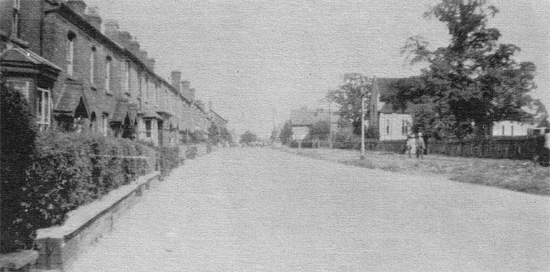
View of the Station Road, Knowle. Many of the Hospital’s personnel were stationed in the private homes pictured at left.
During the meal, it was announced that the Hospital’s staff would be billeted in private homes throughout the village, and although difficult at first to believe, everyone was pleased to finally have a warm place to bed down. Having completed messing, the personnel were directed to their billets and spent the next two days resting and acquainting with the local neighborhood. Calisthenics were also provided for all staff, and further classes were held in anatomy and physiology, first aid and chemical warfare. In addition to this, a two-day course was provided in the assembly and firing of the M1 Carbine.
On 6 June 1944, the 7th knew that its days in Knowle were numbered; following the Allied landings in Normandy many of the staff knew that the Hospital’s skills and facilities would eventually be required somewhere on the continent. At the beginning of August 1944, the unit received orders to break up camp and prepare for movement to the continent. All staff assisted in striking tents, packing away supplies and loading vehicles. By 7 August 1944 everything had been squared away and the unit was ready to depart Knowle.
The following day the unit was instructed to march to the same train station into which it had arrived, and to board another train to Eastleigh. At 1000 hours on 8 August the unit moved out in formation. The whole village lined the streets all the way to the station, where another large crowd of locals were waiting to bid the “Yanks” farewell.
By 1800 hours the 7th had reached its new location at Eastleigh, Hampshire and detrained. US Army transportation was waiting and the men quickly boarded trucks for another location. At 2000 hours, the trucks stopped and the staff unloaded with their equipment at Camp C-5 (near Winchester, Hampshire –ed). This Camp was to act as a Staging Area for the unit, and the personnel were instructed to bed down in the numerous Pyramidal Tents that had already been erected.
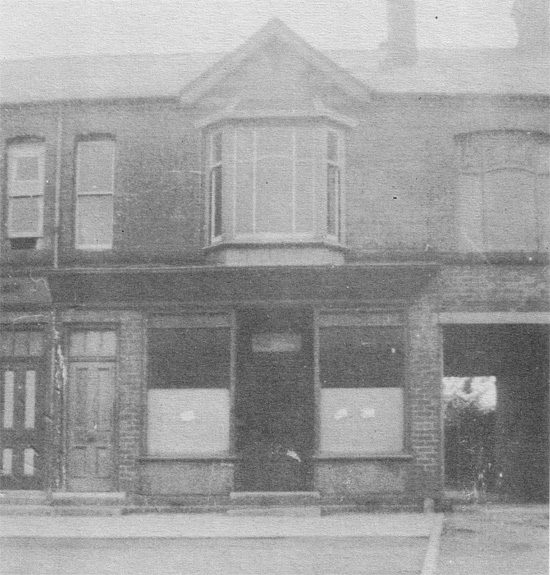
This building in Knowle was used as the unit’s Headquarters. It is a converted shop front, with appartments above. Photograph taken in February 1944.
A two-day waiting period was endured by all, but finally at 0600 on 11 August 1944 orders were received to leave the Staging Area and head to Southampton. Most of the day was spent preparing everything, and at 1600 hours, the men boarded Army transport and left for the embarkation area.
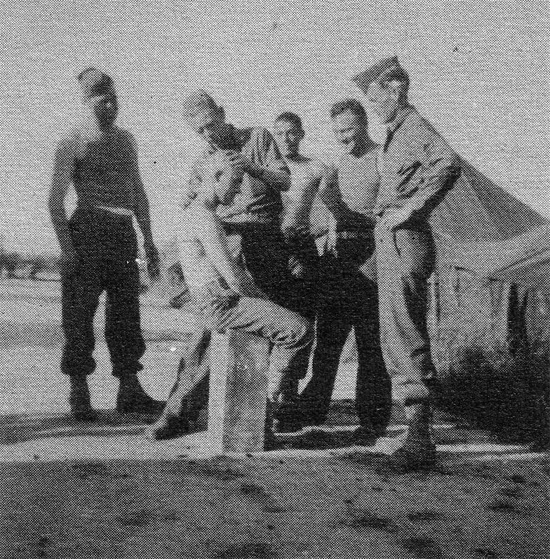
In readiness for the movement overseas, Hospital personnel received haircuts at the Staging Area.
Arriving in Southampton at approximately 1745, the staff unloaded their personal equipment and boarded the transport ship “HMS Empire Gauntlet”. The destination was thus far unannounced, but it was largely speculated to be Normandy, France.
France:
The trip across the English Channel was calm and uneventful. Early in the evening of 12 August 1944, the landing barges approached the now anchored transport ship and personnel of the Hospital descended down rope ladders on the side of the vessel and loaded into the waiting craft. The debarkation process was slower than expected however. The outfit had been split into two groups, both of which had to make their way separately to the assigned area near to Saint-Germain-de-Varreville. The advance party had already arrived a day with the unit transport, and the personnel pitched Shelter Tents and bedded down. With only K Rations to consume, a period of three days was spent in the field, until orders were received to move closer to the already nearby frontline. The unit loaded its equipment into the transport and was once again on the move.
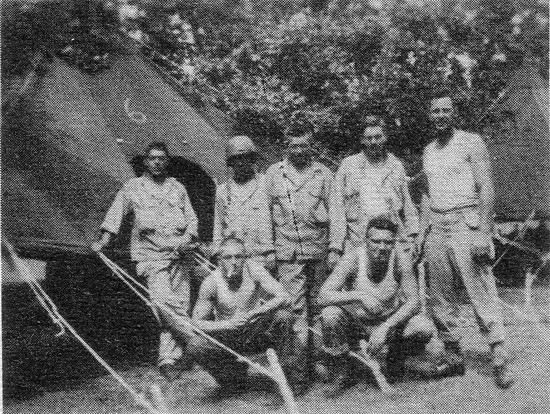
Illustration of an unidentified group of Hospital personnel in front of numerous Pyramidal Tents during the first bivouac in France.
In the early evening of 16 August, the trucks arrived at the new bivouac location, a field situated on the outskirts of La Hulière. This new location was adjacent to the Red Ball Highway, and thus presented a high risk of attack from the air. Orders were issued to pitch tents along hedgerows or under trees, and to otherwise camouflage the tents as well as possible. However, since all of the Hospital equipment remained on the unit transport, it was clear that this was to be just another stopping place for the unit.
Two days later, the surrounding Infantry units had made sufficient ground to allow further advance of the 7th Conv. Hosp. The personnel once again struck their tents, packed everything away and boarded the 2 ½-ton Trucks for a peaceful grassy orchard on the outskirts of Le Mans. This would be home to members of the unit for the next 2 weeks.
Pyramidal Tents were erected and proved a welcome change from the rather cramped Shelter Tents which had been used until this time. In addition, 10-in-1 Rations had been sourced and issued to the personnel, which offered relief from the K and C Rations! Fresh eggs, potatoes and all kinds of fresh vegetables were also sourced by the Mess Section, and for the first time since arriving overseas, mail from home finally reached the members of the unit.

Entrance to the main Hospital complex at Étampes, France. Notice the large sign above the gate, erected by the unit’s staff.
News was received from Colonel Wilson that a more suitable and permanent location had been identified for the Hospital, and so once again tents were struck and the unit was on the move to a new bivouac location in a wheat field just outside Étampes. Upon arrival on 6 September 1944, the unit’s transports stopped before a large U-shaped building, where supplies were unloaded and cots were provided. Everyone in the unit bolted inside for the best room!
Colonel Wilson and Colonel Boyd began formulating plans for the unit while the Hospital Technicians surveyed the buildings for their suitability. Wiring and structures were checked, furniture re-arranged and all the mess of the former inhabitants tidied up and cleared away.
Having entirely cleaned and fumigated the building, the task of equipping it remained. This would prove to be very difficult, since much of the unit’s equipment had not yet arrived, or was not satisfactory for use. As a result, personnel of the unit were sent out on scouting missions to locate anything that might be of use. Luckily, a large German warehouse had been found nearby which was crammed with everything from steel girders to wine glasses. For several days, the unit’s vehicles shuttled hundreds of captured beds, mattresses, lamps, easy chairs, dishes and other equipment that the unit would need. From a Medical Depot in Étampes came the medical, surgical and dental supplies and appliances to supplement the Table of Equipment. Much of the equipment had to then be converted for use; beds had to be painted, mattresses fitted and rooms, wards and departments furnished. Within a matter of days though, a hospital was quickly taking shape.
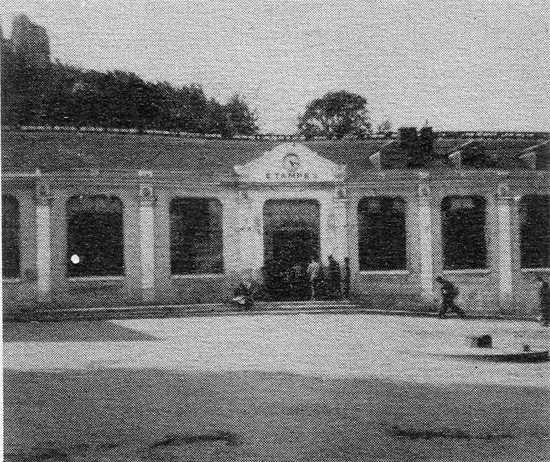
View showing one part of the large U-shaped building in Étampes that was converted for use as a hospital by the 7th.
The mission of the 7th Convalescent Hospital was to provide care for 2,000 convalescent patients and, in addition, provide station hospital facilities for the 19th Reinforcement Depot and other nearby units. It was decided by Colonel Wilson and his staff that the Hospital be divided into a Clinical Section and a Convalescent Section. The U-shaped building became the Clinical Section composed of a Dispensary, EENT Clinic, Surgery, Medical Section, Dental Clinic, X-Ray Department, Orthopedic and Physiotherapy Departments, Medical Supply, Mess Hall and bed capacity for 175 patients.
The Convalescent Section was established in six connected barracks buildings. Four Companies; A, B, C, and D, comprised the section, each Company consisting of a Headquarters, Company Supply Room, Day Room and Patient Rooms.
While bed space had been found to treat 2,000 patients, the Hospital still had no means by which to feed them! No building suitable for conversion to a kitchen existed at the location, and so it was decided that one should be built from scratch. Rough sketches and plans were prepared, concrete mixed and by the end of October 1944, the kitchen had been completed. By this time, the first truckloads of patients had arrived at the hospital, and the staff assisting with the construction of the kitchen were needed to care for them. As such, a Company of Engineers was procured to construct an adjoining mess hall, which was completed on 18 November 1944. Makeshift dining facilities were set up in the barrack rooms for the convalescing patients in the meantime.
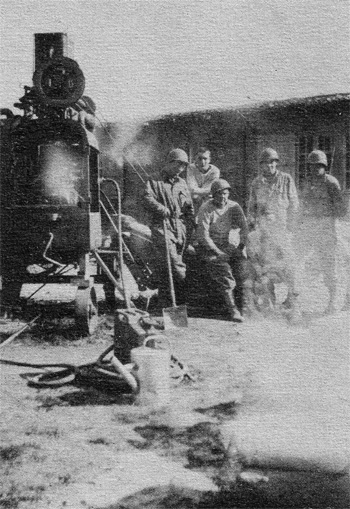
Fumigation equipment was required to ensure that the buildings were fit for purpose.
355 patients had been received from numerous General Hospitals in the Paris area with little advance warning at 1600 hours on 21 October 1944. Despite maximum confusion, the patients were allocated to wards and all registration completed in record time. This provided ideal “on the job” training for the administrative staff, who in the following days allocated a further 500 patients to wards.
Patients arriving at the Hospital were classified into four categories, A, B, C or D, depending upon their physical and mental fitness. Those assigned to class “A” were generally considered physically and mentally fit for return to duty, while class “D” convalescents required much more thorough rehabilitation. A series of programs was introduced to assist in this process. Class “A” patients ran a makeshift assault course (which they constructed themselves) and took calisthenics, undertook long marches and worked themselves into peak condition.
The Clinical Section functioned quietly and efficiently as a 175-bed Station Hospital. Captain Levine was assigned to the Dispensary, and within a few days the outfit had a tremendous out-patient clientele averaging about 100 per day.
During December 1944 and January 1945 the organization’s structure underwent numerous changes. The detachment of patients was becoming too large and unwieldy for the four Companies to handle and so as a result, four additional Companies were added to take care of them. The Companies were then regrouped to form two Battalions, under the command of 1st Lieutenants Homer W. Gill and John C. Thornburg respectively. An additional Training Regiment was also established, with 1st Lieutenant James A. Osman being assigned the responsibility of same.
Based on the assumption that the patients could be better controlled by a display of rank, all Company leaders were issued a new rank of First Sergeant, a trait which earned the 7th the title of “the outfit of First Sergeants”!
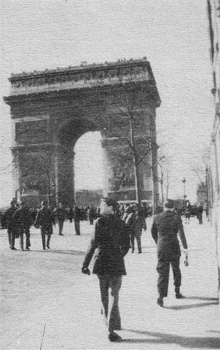
Members of the unit visit the Arc de Triomphe while on leave in Paris.
On 6 February 1945, the unit’s highly revered Commanding Officer, Colonel Wilson suffered from a severe heart attack. Wilson was taken from the Hospital to Paris via ambulance, and Executive Officer Lieutenant Colonel Harvey C. Boyd assumed command.
Despite the tremendous amount of work that was required from each staff member of the unit, time was still found to unwind and relax whenever possible. Local theaters and function rooms provided ideal respite for all. French USO shows were organized, and a highlight was the performance by the Glenn Miller Band. An old barn-like structure next to the Hospital was converted into a gymnasium, and the Stadium on the edge of Étampes was turned into an athletic field which proved very popular among the athletes of the unit.
A weekly dance was held every Friday evening and passes to Paris were also common. The members of the 7th were frequent visitors at the famed Folies Bergère (music hall located in Paris –ed), too, with special parties being arranged by Special Service.

Hospital vehicles line up outside of the buildings at Étampes to transfer personnel and equipment to the new location in Germany.
The hard work continued into March, but by the end of the month it became an open secret that the job of the 7th was about finished in Étampes, and that the unit was to move on to a new location and mission. Patients were discharged to duty, and no new ones arrived and on 31 March 1945, the Convalescent Section ceased operations. The 302d Station Hospital arrived to take over the facility previously occupied by the Convalescent Section, and soon thereafter the Clinical Section was also closed.
An advance party left the unit on 18 April 1945 for Cologne, Germany. The balance of the unit then entrained at Étampes Train Station into “40 and 8s” (“40 hommes et 8 chevaux”, French boxcars for transporting 40 men or 8 horses –ed) on 21 April and departed at approximately 0700 hours.

A member of the American Red Cross lights a patient’s cigarette at the Hospital. This photograph was taken in March 1945.
Germany:
The journey via train to Germany was largely uneventful. The train made numerous stops en route, and the personnel took the opportunity to salvage cans, sheet metal and pieces of wood to make stoves in the car that could be used to heat up the issued K and C Rations. The journey lasted approximately 24 hours, and the train halted at Buir, approximately twenty-five miles outside of Cologne, Germany. There had been some confusion about the correct destination for the unit, and so upon arrival at Buir, Captain Robert R. Maury arranged to have a Quartermaster Company come to the waiting train to carry the unit via truck to its correct location. Thirty 2 ½-ton Trucks finally arrived, and once again the personnel took to loading the trucks with the large amount of equipment that had been procured while in Étampes. Due to the large amounts of equipment and personnel, several shuttle runs had to be arranged to transport everything to the new location in Cologne.
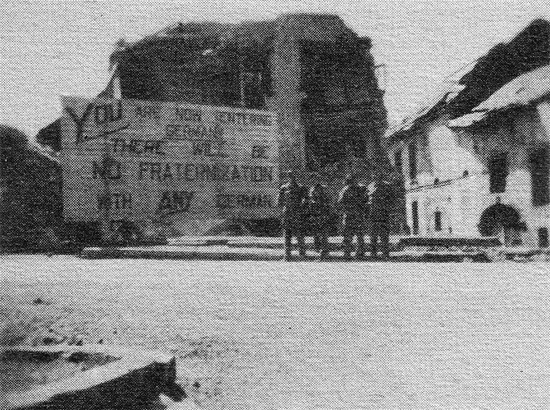
Overview of the bomb-damaged buildings in Cologne, Germany. Also note the large “No Fraternization” panel.
Upon arriving at the Sankt Elisabeth Krankenhaus, many men of the unit were awestricken by its sheer size. The large brick hospital building comprised five storeys, and had suffered damage from aerial bombardment. The men of the 7th knew that this once again represented quite some work to transform the facility into a functioning hospital again.
The building was to be turned into a combination Station Hospital and Displaced Personnel Clinical Center, which required much of the structure to be repaired. The first few days were spent unloading supplies, and little structural work could be carried out. Most of the window panes were replaced and shelving units were constructed. The wiring system had to be completely renovated and all bomb debris cleared from each room.
Even before all work had been completed, the Hospital received numbers of Displaced Persons (DP –ed), Recovered Allied Military Personnel (RAMP –ed) and wounded GIs. Ambulances were arriving at the facility by the dozen and thus the Registrar’s Office was forced to work around the clock to handle each admission. It was soon realized however that despite its large bed capacity, the Krankenhaus would not hold all the patients. To remedy the situation, the 7th incorporated the equipment and personnel of the 64th Field Hospital, which had been functioning as a 750-bed tented annex installed in the Cologne Sportplatz. A great deal of additional planning was required to ensure that the incorporation went smoothly. Pyramidal Tents were struck, repositioned and re-pitched according to plans laid down by Capt. Maury.

Lieutenant General Leonard T. Gerow is pictured here with members of the 7th during his visit to the unit on 31 May 1945.
On 31 May 1945, the Commanding General of the Fifteenth United States Army (Lieutenant General Leonard T. Gerow –ed) visited the Hospital with members from the Senate Military Affairs Committee. Two members of the Hospital’s personnel were assigned as guards for the visit; David A. Averett and Cletus E. Goldsmith. The 7th was commended by the senior staff for the hard work that had clearly been made converting the building for Army use, and the skills displayed by all members of the staff.
On 18 June 1945 after having spent almost two months in the large brick building, the personnel of the unit joined members of the 64th Field Hospital in the Tent City, and all DP and RAMP patients were transferred to surrounding British Royal Army Medical Corps units. Orders had been received from Fifteenth US Army Headquarters to continue in operation, and so a steady stream of GI patients was still admitted.
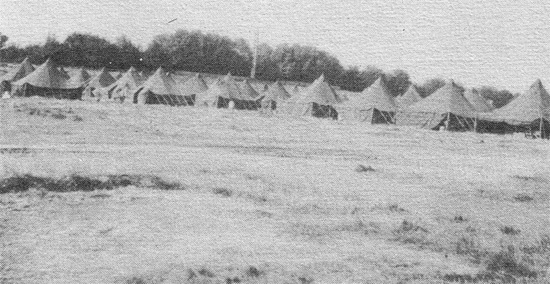
Overview of the various types of tentage erected at the 64th Field Hospital. This Tent City would later be home to the staff of the 7th.
The brief stay in the field was a pleasant one. For most of the men, it was a vacation from their arduous labors, and it was a period of swimming, sun bathing, playing tennis and softball, and relaxing in the “sack”.
News was received early in July that the unit would once again be on the move, this time to Marseille. Packing and loading of unit equipment took place, but was this time expedited by the assistance furnished from a nearby DP Camp. On 9 July 1945, the advance party started out on the long journey, and two days later the remainder of the men once again filed into “40 and 8s” and headed south.
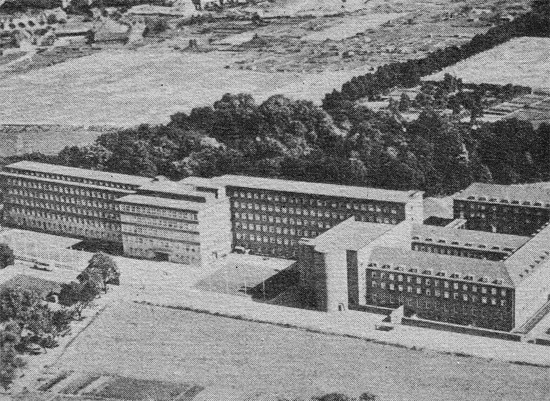
Aerial view of the Sankt Elisabeth Krankenhaus in Cologne, home to the 7th Convalescent Hospital.
The convoy finally arrived into Saint-Louis Station, Marseille on 14 July 1945, after bivouacking at Dijon and Montélimar on the way. The new home for members of the 7th was the Nurses’ Staging Area on the outskirts of the city. The staff were assigned with the responsibility of running the Staging Area. It was a large complex, almost like a self-contained village; there was a chapel, theater, swimming pool, a multitude of two-storey buildings and almost 2,000 American Nurses!
Having had no previous experience of such a mission, the members of the unit certainly had their work cut out. The responsibility had previously been carried out by the 235th General Hospital. It was largely a job of housing, feeding and administration, although the Dispensary, Laboratory and Dental Clinic were once again set up.
The End:
At approximately 1300 hours on 15 August 1945 came the news that everyone in the unit had been waiting for V-J Day! It was a joyous occasion for everyone, with an impromptu show being organized in the theater. Since the CBI no longer beckoned ominously, everyone could look forward to the eventual return home.

Looking down one of the many streets in the Nurses’ Staging Area in Marseille.
ASR (Advanced Service Rating –ed) scores were lowered, and gradually Officers and Enlisted Men of the unit filtered out, returning to their pre-war lives in the Zone of the Interior. October and November passed with more and more staff being returned to the United States, and the remainder of the Hospital returned in early December. Deactivation took place shortly thereafter.
Roster:
| Officers: | |
| Abbott, Donald N. (Maj.) | Levine, Edward J. (Capt.) |
| Amato, Vincent J. (Lt. Col.) | Liebling, Jack E. (1st Lt.) |
| Block, Edward (1st Lt.) | Maury, Robert R. (Capt.) |
| Boyd, Harvey C. (Col.) | Nelgner, Harry H. (Capt.) |
| Bushman, Louis B. (Capt.) | Nelson, Richard W. (1st Lt.) |
| Daft, George R. (1st Lt.) | Osman, James A. (1st Lt.) |
| Dahlk, Waldemar W. (Capt.) | Oswald, Stephen M. (1st Lt.) |
| Feinberg, Ruben (1st Lt.) | Rachlin, Sol (Capt.) |
| Garbas, Anthony L. (Capt.) | Redmond, Ralph N. (Capt.) |
| Gill, Homer W. (1st Lt.) | Rocco, Nicholas J. (Capt.) |
| Golden, Walter H. (1st Lt.) | Sause, Jabob B. (Chaplain) |
| Gregory, James W. (Capt.) | Smith, Hubert F. (Capt.) |
| Hamlin, Courtney N. (Maj.) | Speca, John (1st Lt.) |
| Hasty, Willis A. (Capt.) | Stewart, Robert M. (Capt.) |
| Hirchfield, Stanley A. (Capt.) | Sutton, Joseph C. (2d Lt.) |
| Hofrichter, David C. (Capt.) | Thomas, Edward W. (Capt.) |
| Ingram, David R. (Capt.) | Thornburg, John C. (1st Lt.) |
| Johnson, Charles C.(1st Lt.) | Welte, Fred H. (Maj.) |
| Jones, Courtland S., Jr. (Capt.) | Wilson, William B. (Col.) |
| Keith, Theodore K. (Capt.) | Witt, Wandall D. (Capt.) |
| Landry, Thomas B., Jr. (Capt.) |
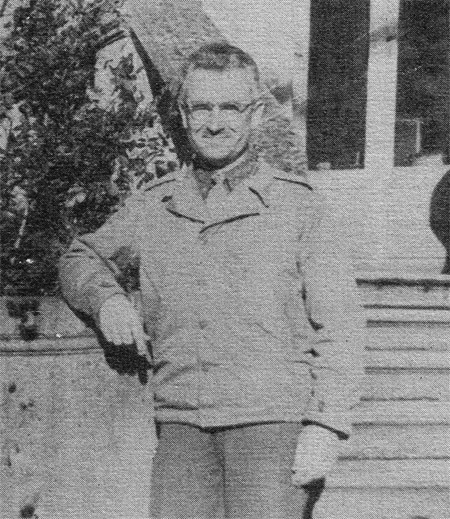
Jacob B. Saus, the 7th Convalescent Hospital Chaplain.
| American Red Cross: | |
| Donnellan, Elizabeth | Sachs, Nadine |
| Maguire, Dorothy E. | Sumter, Winon |
| Marshall, Edith | |
| Enlisted Men: | |
| Albro, William G. | Laux, Alfred E. |
| Anderson, Carl W. | Lester, Edward W. |
| Auger, Arnold D. | Levin, Norman |
| Ault, Donald E. | Loader, Frank |
| Averett, David D. | Lombardo, Anthony |
| Bagwell, Luther L. | Lowe, Albert F. |
| Balesh, Fred J. | Mackin, Joe B. |
| Bandurich, Joseph S. | Madrid, Ernest C. |
| Barnes, Bud | Maisenholder, Roger F. |
| Bates, Forest D. | Malgieri, Ralph R. |
| Baumgardner, Lloyd H. | Mariani, Branko |
| Beach, Jack T. | Marko, Charles E. |
| Beasley, Robert H. | Martin, Oral F. |
| Behne, Harold E. | Martinez, Marcelo |
| Benjamin, Robert L. | Mayfield, Lisle E. |
| Berns, Joseph | McAlexander, Herbert H. |
| Blevens, Thomas J. | McClure, Stanley E. |
| Bogseth, Oliver C. | Merrit, Milo F. |
| Braun, Lawrence | Meters, Irvin |
| Brideau, Donald J. | Michalek, Robert J. |
| Brown, Marion E. | Miller, Charles G. |
| Brown S. J. | Milstein, Benjamin |
| Bundle, Ordner T. | Minerd, Herbert W. |
| Busch, Samuel M. | Mondella, Louis P. |
| Caldwell, Jay | Montgomery, Carl R. |
| Cantrell, Carson H. | Mordus, Robert J. |
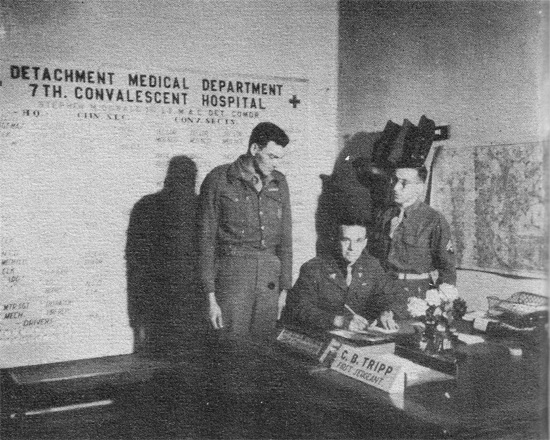
View of the Medical Detachment of the 7th Convalescent Hospital in Germany, 1945.
| Capestrain, Raymond R. | Moser, George E. |
| Carrico, James | Namestnik, George E. |
| Casserman, Jacob P. | Nichol, Matthew W. |
| Castellano, Anthony F. | Noel, Nicholas D. |
| Chapman, James B. | Notto, Alfred A. |
| Chidester, David B. | O’Neill, Herbert D. |
| Chism, Thomas W. | Olson, Asmund N. |
| Clulee, Willie J. | Orlansky, Morris |
| Coker, Charles F. | Ortner, Joseph L. |
| Comfort, Thomas F. | Palkovitz, Aaron I. |
| Cook, Joseph A. | Paris, Lawrence E. |
| Cooper, Clyde W. | Patterson, Preston |
| Cooper, Wendell B. | Patton, Hugh B. |
| Cosmos, John C. | Perez, Emilio |
| Coulthurst, James L. | Perez, Jesus G. |
| Cram, Lloyd B. | Pestow, Earl H. |
| Crawford, Christopher J. | Prefer, David K. |
| Culver, Clyde H. | Prete, Agostino A. |
| D’agostino, Guido A. | Probst, Leslie B. |
| Davis, Donald B. | Pusateri, Joseph |
| Davis, Donald, L. | Ranghelli, Anthony F. |
| Davis, Floyd F. | Reid, Melville H. |
| Dayton, John L. | Roberts, Robert C., Jr. |
| Dearing, William | Robinson, Harold C. |
| Deistchle, Jack W. | Rogers, Grover V. |
| DeLise, Tony B. | Rogowski, Anton J. |
| Dente, Charles C. | Roseen, Bertil R. |
| Dial, Julian S. | Roy, Herman |
| Domingue, Anthony J. | Rudolph, Kenneth E. |
| Dressen, Richard L. | Sanford, Adrian C. |
| Dufala, Joseph | Savino, Leonard |
| Eason, Aubrey A. | Scheuble, Curtis L. |
| Edgar Willard L. | Schwartz, Marvin M. |
| Edge, Roy A. | Schwarz, Leo W. |
| Egner, Richard B. | Sebastian, Leno L. |
| English, Walter E. | Shaw, Richard N. |
| Espinosa, Joseph H. | Shelby, William L. |
| Farrell, Daniel C. | Silva, Manuel A. |
| Ford, John E. | Simmons, Lewis M. |
| Forsberg, Everett M. | Simonton, Leon O. W. |
| Galchutt, William H. | Simpson, Geroge E. |
| Garner, Glennie W. | Skelton, Frank H. |
| Gersten, Eugene J. | Skvarek, Matthew S. |
| Gibson, Oliver D. | Smid, Irvin |
| Gilliland, Talmage L. | Smith, Irving |
| Glazman, Sidney | Smith, Robert J. |
| Goldsmith, Cletus E. | Smith, Vernon L. |

Enlisted Men of the unit prepare to board transport for Marseille. Most of them have ‘souvenirs’ from their time in Germany attached to their personal equipment!
| Green, James | Sochan, Rudolph |
| Grindle, Frederick L. | Sopata, Chester S. |
| Gross, Herbert | Stallings, David W. |
| Gutierrez, Andres | Starzyk, Frank J. |
| Halker, Harold F. | Stassi, Vincent J. |
| Hand, Robert G. | Stein, Robert |
| Hanlin, Charles H. | Stevens, Taylor L. |
| Harris, Robert B. | Stinnette, James L. |
| Hartung, Harold K. | Stockton, Vernon F. |
| Heflin, Storman | Stoner, David P. |
| Heikkila, Onni A. | Stringer, David D. |
| Heil, Robert F. | Stuhr, Thomas C. |
| Heilbrunn, Berthold | Superfine, Edwin A. |
| Hellmuth, Weston F. | Terry, L. C., Jr. |
| Hendrickson, Lonnie E. | Thomas, Ivor |
| Henson, Paul B. | Tokarz, Edward G. |
| Hernandez, Santos A. | Tosti, Louis, Jr. |
| Housley, George W. | Tremblay, Florent C. |
| Howell, Jake B. | Tripp, Chester B. |
| Hurd, Oliver C. | Trusty, Glen C. |
| Jackson, Arthur I. | Ufen, Henry |
| Johnson, Harold C. | Vallans, Harold |
| Johnson, Lewis C. | Vest, Paul F. |
| Johnson, Robert E. | Wasson, Sidney E., Jr. |
| Jurgites, Ralph A. | Weiss, Norbert L. |
| Kalberer, Thomas E. | Weissbein, Sol |
| Kalson, Leo | Wilkerson, Crawford L. |
| Kaminski, Henry S. | Williamson, Allen E. |
| Kerrigan, Eugene J. | Wittig, Albert R. |
| Kervick, Bernard A. | Wolff, Morrel J. |
| Kidd, Aaron J. | Woodruff, Jack |
| Klein, Louis | Worby, Donald J. |
| Langevin, Oliver J. | Yelton, Edgar L. |
| Larson, Arland M. | Young, Charles F. |
| Lauback, Herman L. | Young, Wilson R. |
The MRC Staff are forever indebted to Steven Chaplin (United Kingdom) who kindly furnished them with an original book documenting the history of the 7th Convalescent Hospital, as well as numerous other materials relating to the unit. This Unit History would not have been possible without his most precious assistance. The MRC is still looking for more specific details relating to the deactivation of the 7th Conv. Hosp. If you are able to assist, please contact us.
